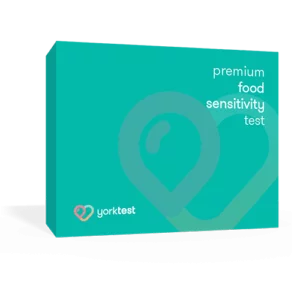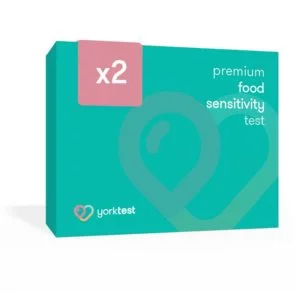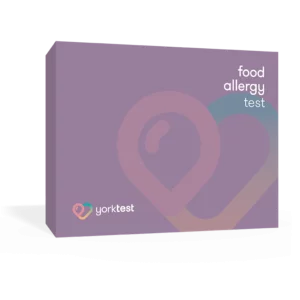- What is a hazelnut allergy?
- How common are tree nut allergies?
- What are the symptoms of hazelnut allergy?
- Oral Allergy Syndrome (OAS)
- What’s the difference between Hazelnut Allergy and Hazelnut Intolerance?
- What are the Risk Factors Associated with Hazelnut Allergy?
- What foods to avoid if youâre allergic to hazelnuts?
- How to test for a Hazelnut Allergy?
- How to Treat a Hazelnut Allergy?
- Identify a hazelnut sensitivity with YorkTest
Of all tree nut allergies, hazelnut allergy is one of the most prevalent types. In the United States, hazelnut allergy affects 0.2% to 0.5% of people. It commonly manifests at a young age and then persists for life.
An allergy to hazelnuts should not be taken lightly, symptoms can range from mild reactions like hives and itchy skin to severe reactions like anaphylaxis, a potentially life-threatening allergic response that impairs breathing and can send the body into shock.
In fact, tree nut allergies – like hazelnut allergy – account for 18 to 40% of anaphylaxis cases. Worryingly then, many people are not fully informed about their tree nut allergies. One study found that only half of the participants with a tree nut allergy correctly identified every type of nut they were allergic to.
If you’re experiencing severe symptoms, you should always seek medical advice. However, if you suspect hazelnuts could be triggering a mild reaction, this guide can help. We’ll outline the symptoms of a hazelnut allergy, the differences between an allergy and a sensitivity, other cross-reactive foods you should be mindful of consuming and ways to test for and manage a hazelnut allergy.
What is a hazelnut allergy?
As mentioned, hazelnut allergy is a common type of tree nut allergy. An allergic reaction occurs when the body incorrectly perceives the proteins in hazelnuts as a threat, and releases immunoglobin E (IgE) antibodies.
How common are tree nut allergies?
A vast majority of tree nut allergies stem from the following varieties: almonds, Brazil nuts, cashews, hazelnuts, macadamia nuts, pecans, pine nuts, pistachios, and walnuts.
The different types of tree nut allergies are not mutually exclusive. Approximately 30% of individuals with a tree nut allergy are allergic to more than one nut.
A peanut allergy is not a tree nut allergy. Peanuts are classified as a legume. However, 20 to 30% of people with a peanut allergy are also allergic to at least one type of tree nut.
What are the symptoms of hazelnut allergy?
Hazelnut allergy symptoms can range from mild to severe, and they typically occur within minutes of ingestion. Some common symptoms of hazelnut allergy include:
- Abdominal pain, cramps, nausea, and vomiting
- Diarrhea
- Difficulty swallowing
- Itching near the mouth, throat, eyes, and skin
- Hives
- Swelling of lips, tongue, or face
- Nasal congestion, runny nose
- Shortness of breath
- Wheezing, sneezing, or coughing
- Anaphylaxis, a potentially life-threatening event
As mentioned above, hazelnuts carry a higher risk of anaphylaxis compared to other food allergies. You should seek emergency medical assistance immediately if you show any signs of anaphylaxis.
Oral Allergy Syndrome (OAS)
Allergy symptoms can manifest as a result of oral allergy syndrome (OAS) – or pollen-food allergy syndrome – a type of food allergy that affects the mouth and throat. OAS can occur in people who are allergic to pollen, such as birch pollen, and who also have a sensitivity to certain foods, such as hazelnuts.
OAS symptoms are usually mild and do not progress beyond the mouth and throat. They’re often characterized by symptoms like an itchy mouth and hives on the mouth, scratchy throat, and swelling of the lips, mouth, tongue, and throat.
What’s the difference between Hazelnut Allergy and Hazelnut Intolerance?
Hazelnut allergy and hazelnut intolerance, also called hazelnut sensitivity, are two different conditions with distinct mechanisms and symptoms. Here are some key differences between the two:
- A hazelnut allergy elicits an IgE antibody immune response whereas a sensitivity triggers an IgG antibody response.
- Symptoms of an allergic reaction can begin immediately, or shortly after, contact with a trigger allergen. On the other hand, symptoms of hazelnut sensitivity can take up to 72 hours to appear.
- The typical profile of symptoms differs. Whilst a hazelnut allergy is linked to swelling, itching and sneezing, a hazelnut sensitivity is more likely to trigger symptoms such as:
- Diarrhea
- Bloating
- Skin conditions e.g. eczema or psoriasis
- Headaches
- Fatigue
If you’re experiencing any of the symptoms on the list above, we recommend taking a Premium Food Sensitivity Test to see whether hazelnuts are triggering an IgG reaction in your body.
Sensitivities aren’t always for life! If you have a food allergy, you should avoid that food for the rest of your life. With a hazelnut sensitivity, you may be able to reintroduce hazelnuts into your diet after an elimination diet and under the advice of a nutrition professional.
What are the Risk Factors Associated with Hazelnut Allergy?
There are certain risks and contributing factors associated with hazelnut allergy, including:
- Family History: People with a family history of allergies are at higher risk of developing a tree nut allergy, including hazelnut allergy.
- Allergic Diseases: Hazelnut allergy is associated with other allergic diseases, such as food allergies, asthma, atopic dermatitis, and allergic rhinitis.
- Cross-Reactivity: People with an allergy to other tree nuts, fruits, soybeans, vegetables, and legumes may also have a hazelnut allergy due to cross-reactivity.
The exact cause and risk factors of developing a hazelnut allergy are not fully understood, and they may vary from person to person. Just because a parent has a hazelnut allergy doesn’t mean their child will definitely develop one too. Likewise, many people who react to hazelnuts don’t have any family history of food allergies.
What foods to avoid if you’re allergic to hazelnuts?
While hazelnuts might not be top of your weekly grocery list, they can be found in a wide range of foods. If you are allergic to hazelnuts, it is important to be aware of all foods that may contain hazelnuts, including unspecified nuts, such as chopped or mixed nuts.
Some of the most common types of foods that contain hazelnuts are:
- Cookies, cakes, pastries, and other baked goods
- Chocolates and confectionery products
- Nut butters and spreads, like the popular hazelnut spread Nutella
- Ice cream and frozen desserts
- Breakfast cereals
- Bread and other baked goods
- Pralines and other nut blends
- Some alcoholic beverages, such as hazelnut liqueur
- Certain salad dressings and sauces
It’s vital to carefully read food labels and avoid any foods that contain hazelnuts or unspecified nuts. People with hazelnut allergy may also be allergic to other tree nuts, legumes, fruits, and vegetables, so it’s also important to be aware of cross-reactivity between these foods.
How to test for a Hazelnut Allergy?
To effectively test for a hazelnut allergy, there are several approaches that can be used. In most cases, your allergist or healthcare provider will first ask you about your allergy symptoms and their relationship to hazelnut consumption. This history will help in determining what type of testing may be necessary to determine an allergy.
The most common types of hazelnut allergy tests include:
Skin Prick Test: An allergist places a small amount of hazelnut extract onto the skin – usually the forearm or back. The skin is then pricked with a small needle. If raise bumps, redness or swelling occurs, this indicates an allergy to hazelnuts.
Blood Test: A blood test measures the levels of Immunoglobulin E (IgE) antibodies in response to the suspected allergen – in this case hazelnut. High IgE levels suggest an allergic reaction is likely occurring. This method is very convenient as you can purchase a home-to-laboratory Food Allergy Test.
Elimination Diet: Individuals can also eliminate hazelnuts from their diet temporarily before reintroducing them in controlled amounts while monitoring any reactions closely. This should only be attempted under supervision from a medical or nutrition professional.
The downside to this testing method is that an elimination diet alone can’t differentiate between an allergy and sensitivity. If someone has an allergy to hazelnuts, then they should not attempt to re-introduce them to their diet.
How to Treat a Hazelnut Allergy?
The primary treatment for a hazelnut allergy is to avoid hazelnuts altogether, including any food products that contain hazelnuts. This is the only effective way to prevent an allergic reaction.
Here are some tips for allergy management:
Avoidance strategies: Read food labels carefully to identify any potential sources of hazelnuts. Be cautious of cross-contamination in food processing facilities or when dining out.
Medication: Antihistamines may help relieve mild symptoms, such as itching, if you accidentally consume hazelnuts. But they do not stop the progression of an allergic reaction and are not a substitute for avoiding hazelnuts.
Emergency Treatment: In the case of a severe allergic reaction or anaphylaxis, epinephrine (adrenaline) is the emergency treatment of choice. Epinephrine auto-injectors, such as an EpiPen, should be carried by individuals with a hazelnut allergy at all times. If experiencing symptoms of anaphylaxis, administer epinephrine immediately and seek emergency medical attention.
There is currently no curative treatment for hazelnut allergy. Therefore, strict avoidance of hazelnuts and preparedness for emergency situations is crucial for individuals with this allergy. Consult with a healthcare professional for personalized advice and guidance regarding the management of your hazelnut allergy.
Identify a hazelnut sensitivity with YorkTest
If you suspect you have a sensitivity or allergy to hazelnuts or other types of tree nuts, consider taking one of the following tests from YorkTest. We specialize in home-to-laboratory food sensitivity and allergy tests which assess how a person’s immune system reacts to specific foods and drinks.
- Premium Food Sensitivity Test is ideal for adults 18+. The test analyzes an individual’s IgG reactivity to 200 foods and drinks, including hazelnuts.
- Junior Food Sensitivity Test is ideal for kids aged 2-17. It also analyzes IgG reactions but has been designed to better suit children’s diets.
- Food Allergy Test is suitable for anyone aged 18+. The test analyzes an individual’s IgE reactivity to 23 foods, as well as 18 common environmental allergens.
These tests are easy-to-use and provide personalized results that can help you identify trigger foods in your diet.








